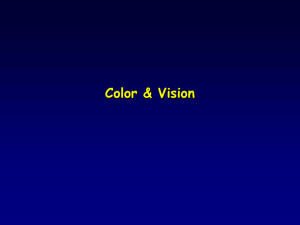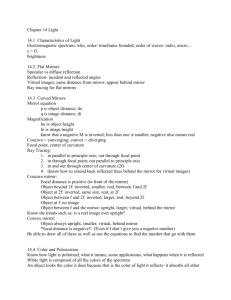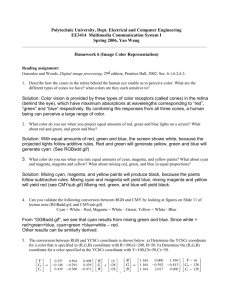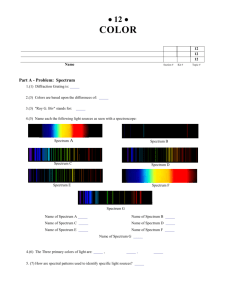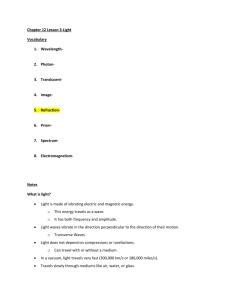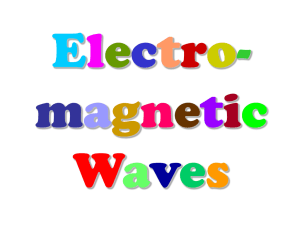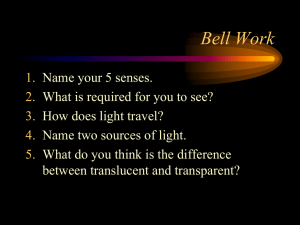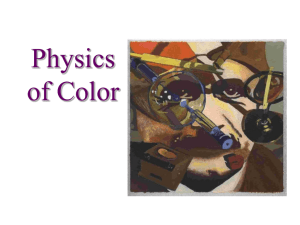Name: Color Visible Spectrum: ROYGBIV Additive Primary Colors
advertisement
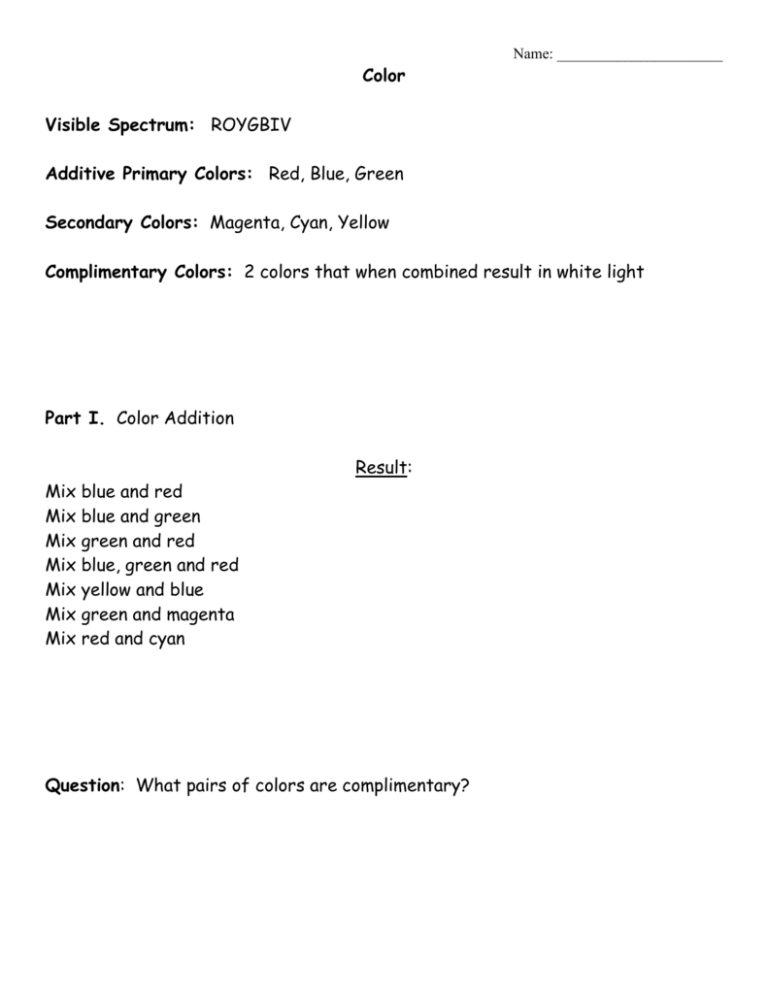
Name: ______________________ Color Visible Spectrum: ROYGBIV Additive Primary Colors: Red, Blue, Green Secondary Colors: Magenta, Cyan, Yellow Complimentary Colors: 2 colors that when combined result in white light Part I. Color Addition Mix blue and red Mix blue and green Mix green and red Mix blue, green and red Mix yellow and blue Mix green and magenta Mix red and cyan Result: Question: What pairs of colors are complimentary? Part II. Color Subtraction – pigments absorb color, we see what gets reflected, or what gets allowed through a filter. Stack 2 filters on top of each other…what color light gets through? Primary Colors: Result Mix blue and red Mix blue and green Mix green and red Secondary Colors: Cyan & Yellow Cyan & Magenta Magenta & Yellow Primary & Secondary: Blue & Cyan Blue & Magenta Blue & Yellow Red & Cyan Red & Magenta Red & Yellow Green & Cyan Green & Magenta Green & Yellow Question: Why is it that in the Primary & Secondary Section, 3 pairs allow no light to go through? What do all those pairs have in common? Color Lab Extension: So we know when mixing the primary colors of light: Blue + Green = Cyan Blue + Red = Magenta Green + Red = Yellow So there are 3 secondary colors of light: cyan, magenta, yellow. Also, white light is the combination of all colors: Red + Blue + Green = White Filters and pigment: Filters and pigment absorb certain colors of light, and reflect (in the case of pigment) or let the other colors through (in the case of filters). We see what doesn’t get absorbed by the pigment or filter!! Example1: When I shine white light through a blue filter, the blue filter absorbs the red and green light and lets the blue light through. Example2: When I shine white light on a yellow banana, the yellow banana absorbs blue light, it reflects the leftovers (red & green) which are combined to make yellow. Example3: When I shine magenta light (red & blue) through a cyan filter, the cyan filter (which only allows blue and green light through) will absorb the red light and let the blue light through, so I see blue. Example 4: When I shine magenta light (red & blue) on a red apple, the apple will absorb the blue light and reflect the red, so I see red. Example 5: When I shine cyan light (blue & green) on a red apple, the apple absorbs both the blue and green so the apple won’t be illuminated (we see black). Example 6: Shine magenta light (red & blue) on a cyan piece (blue & green) of paper, the paper will absorb the red and reflect the blue, so we see blue (what they have in common). Questions: Hopefully you can generalize some patterns from what we’re doing here. 1. Name all possible combinations of 2 filters that will allow blue light through: a) blue & blue b) c) d) e) f) 2. Subtract yellow light from white light, what do you get? 3. Subtract red light from white light, what do you get? 4. Subtract green from yellow light, what do you get? 5. What colors can of light can you shine on a blue pigment and end up seeing blue? a) blue b) c) d) 6. Green light on a yellow lemon, you see: 7. Blue light on a yellow lemon, you see: 8. Red light on a yellow lemon, you see: 9. Cyan light on a yellow lemon, you see: 10. Magenta light on a yellow lemon, you see: 12. Yellow light on a yellow lemon, you see: 13. White light on a yellow lemon, you see: 14. Green light on a green lime, you see: 15. Blue light on a green lime, you see: 16. Red light on a green lime, you see: 17. Cyan light on a green lime, you see: 18. Magenta light on a green lime, you see: 19. Yellow light on a green lime, you see: 20. White light on a green lime, you see: As a kid we learned the primary colors are red, blue, and yellow…how can this be? These are the primary colors of subtraction, and they are really magenta, cyan, and yellow. We were taught that if you mixed blue and yellow paint, you get green. 21. In reality, if you mix cyan and yellow paint, what is the only color that gets reflected when you shine white light on it? 22. Black object appear black, because what colors of light do they absorb? 23. What colors of light do white objects absorb?
